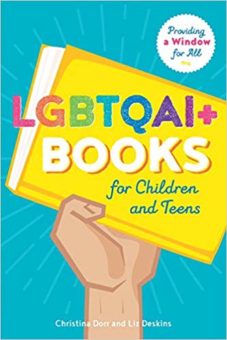Where to Find Kids’ LGBTQAI+ Books
LGBTQAI+ Books for Children and Teens: Providing a Window for All
By Christina Dorr and Liz Deskins
(American Library Association, 2018 – Learn more)

The cover of LGBTQAI+ Books for Children and Teens shouts the book’s power with an upraised hand clutching a bright yellow book.
For librarians Christina Dorr and Liz Deskins, getting the right book into the hands of the right kid at the right time is paramount – even more so when the topic is something not everyone wants to talk about.

In addition, LGBTQAI+ Books argues that librarians can’t justify not including such titles in their collections simply because students don’t ask, or because the books don’t seem to circulate, or because a community challenge is likely. Throughout, it reminds us that librarians often step in as first-line defenders of intellectual freedom. The epilogue is titled “It’s about Basic Human Rights,” and this anti-censorship theme recurs throughout.
Where to Start
The book begins with a powerful personal story by Jamie Campbell Naidoo, past president of the Association for Library Service to Children. The authors then discuss justifications for circulating LGBTQAI+ literature to children and teens, a brief history of such literature, approaches to “dealing with objections,” and helpful vocabulary. LGBTQAI+ in the title refers to lesbian, gay, bisexual, transgender, queer, asexual, intersex and more.
Attempting from the outset to defuse concerns, the authors point out: “We no longer hesitate to share books about other forms of diversity: race, ethnicity, socioeconomic status, age, language, women’s issues, and more. Why are we still hesitant to share books about sexual orientation, gender identity and expression, and nontraditional family structures with all children?”
The rest of the guide divides into three sections, focused on young, middle grade and teen readers.
For the Littlest Kids
In a preface to the young readers’ section – focusing on babies and children – the authors insist that “all family structures need to be validated” and that “children become aware of gender identity/expression at a very young age.”
I found myself taking note of many of the titles, particularly Stonewall Honor Books, to recommend to new parents. I also appreciated, in this section and throughout, the weaving of classics, such as Everywhere Babies by Susan Meyers and Marla Frazee, with newer titles, such as Baby’s First Words by Christiane Engel.
The historical fiction and information section also featured books about everyone from author Gertrude Stein to artist Keith Haring to tennis greats Martina Navratilova and Chris Evert.
For Tweens and Middle Grades
The second section pinpoints the essential balancing act of middle schoolers: to “cling to the support of the family, while simultaneously pushing authority figures away as they begin to think for themselves and develop an independent sense of self.”
I enjoyed this section’s broad landscape of titles, from the graphic novel Drama by Raina Telgemeier to Who Is Elton John? by Kirsten Anderson. It also includes the Magnus Chase series by Rick Riordan as a wildly popular set of books that incorporate gender fluidity.
With both the middle and high school chapters, the authors acknowledge that “there’s a preponderance of realistic fiction,” appropriate to readers’ search for identity.
For Teens and High School
Older teens, the authors point out, “need tools for guidance: family, friends, teachers, counselors, and books,” all of which can provide “a sense of safety,” “the need for respect,” and “a sense of fairness and justice.”
Happily, as you may have noticed with YA literature over the past five or ten years, “the wealth of LGBTQAI+ books that explore every facet of identity and relationship is exploding,” and this chapter gives a fabulous starting point with its three dozen titles.
I had read a handful of them already – interestingly, all because of repeated and impassioned student recommendations – including John Corey Whaley’s Highly Illogical Behavior, Benjamin Alire Saenz’s The Inexplicable Logic of My Life, Emily M. Danforth’s The Miseducation of Cameron Post and Francesca Lia Block’s Weetzie Bat, which “shattered concepts of what a young adult title could be” when it appeared in 1989.
Now I want to work my way through the entire chapter. And if another edition comes out in the future, I would suggest adding Brandy Colbert’s Little & Lion and Amy Ellis Nutt’s Becoming Nicole: The Transformation of an American Family.
Let’s Get This Book into the Right Hands
Who would benefit from this book? Obviously librarians, both those facing challenges and those free to develop a collection without restraint. Teachers, for sure, who want to stock their classroom libraries with books from a diversity of perspectives and who, like me, want to amp up their YA reading lists. Even parents, including those who would like a book they can consult as their kids grow up and have new questions.
In their endnote, Dorr and Deskins focus on the children, young adolescents and teens who should occupy the center of the discussion: “Whatever our beliefs, values, religions, political stances, we aren’t the important piece of the equation – the child is. We need to step back, evaluate the child’s needs, and provide the resources and opportunities to allow the child to learn, question, and grow while encouraging others outside the LGBTQAI+ community to understand and develop empathy.”
Sarah Cooper teaches eighth-grade U.S. history and is dean of studies at Flintridge Preparatory School in La Canada, California, where she has also taught English Language Arts. She is the author of Making History Mine (Stenhouse, 2009) and Creating Citizens: Teaching Civics and Current Events in the History Classroom (Routledge/MiddleWeb, 2017). She presents at conferences and writes for a variety of educational sites. You can find all of Sarah’s writing at sarahjcooper.com.






























